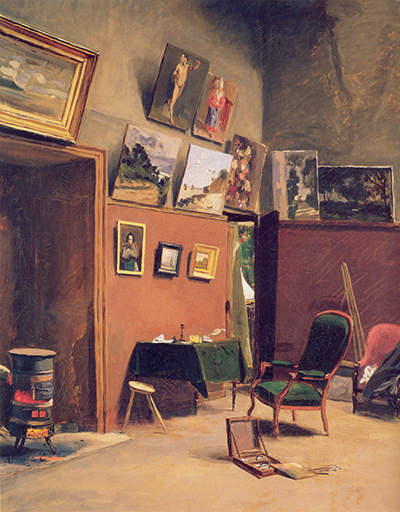Discover more about this talented French painter in our extensive Frederic Bazille biography.
Frederic Bazille was one of the first impressionists, best known for his paintings of portraits, often in an outdoors setting. Born in Montpelier in the south of France in 1841 to a wealthy, middle class family, Bazille became interested in art after seeing paintings by Eugene Delacroix. However he was to study medicine, initially in Montpelier, before continuing these studies in Paris from 1862. Yet his interest in painting never left him and he began attending the workshop of Charles Gleyre at the School of Fine Arts. It was at this time he met and became friends with Claude Monet, Pierre-Auguste Renoir and Alfred Sisley. In 1864 the course of his life became set when he failed his medical examinations and he turned to painting full time with the blessing of his parents.
Prior to finding out he had failed his exams Bazille had spent time with Monet and a few fellow artists in the forest of Fontainebleau over the Easter period of 1863. Monet had emphasised to Bazille the need to leave the confines of the studio behind and to head outdoors, where they could paint en plein air. These early impressionists were interested in the natural world and the science surrounding it and they were also interested in the effects of natural light on the subjects of their paintings. The Fontainebleau Forest became the subject of a painting by Bazille in 1865, although he was to favour more traditional styles and subjects than his contemporaries, particularly portraits over landscapes.
By 1865 Frederic Bazille was sharing a workshop with Monet and submitted work to the official Salon of 1866, with Still Life With Fish accepted. From this point Bazille was often admitted to exhibit his work at the Salon, although he still had some of his paintings refused. Also influenced by Edouard Manet, who he became friends with, Bazille was to produce a series of paintings up until his early death in 1870. This was the year he produced perhaps one of his best known paintings Studio in rue de la Condamine, in which he depicts himself surrounded by his artist friends, including Monet, Manet and Renoir.
Frederic Bazille's work was all produced at such a relatively young age as he died in 1870 when still just 28 years old. He had volunteered in a light infantry regiment of the French Army, called the Zouaves, in August 1870 and went off to fight in the Franco-Prussian war. On November 28th he was killed leading an assault on a German position at Beaune-la-Rolande and was later buried back in his home city of Montpelier.
One of his best known works is The Pink Dress which he painted in 1863, when he was just twenty three years old. Now residing in the Musee d'Orsay, it is an early example of his love for portraits depicted within variations of natural sunlight. The figure we see in the painting is his cousin Therese des Hours and she is shown with her back to the painting's viewer as she looks out across to a village. Bazille places the trees in the middle part of the painting to help emphasise the difference between what is set in the foreground and that which is further away, down toward the village. Traditionally you would expect to see the figure in a portrait looking towards the front, not with their back to the viewer. The positioning here suggests a scene of calmness, one of being at natural ease. The contrast between his cousin sat in the shade and the village set in beautiful sunshine is a familiar Bazille trait.
Three years later in 1867 Bazille produced perhaps his best known painting, Reunion de Famille. This oil on canvas painting also resides in the Musee d'Orsay and once more presents figures within an outdoor scene. This is a large painting, 150cm x 230cm in size, and again uses his own extended family to construct the theme. The tree which shades the family members allows Bazille to illustrate the contrasts between the brightness of the sky and landscape beyond, compared to the shade beneath the tree. This use of natural light is further explored by having some of the light penetrate on to clothing in a dappled effect. This allows him to produce more contrasts in colour, this time within the predominantly shaded area under the tree.
Both these pictures illustrate Frederic Bazille's use of broad brush strokes within structured paintings, which often feel like they could be photographs. Although recognised as one of the early impressionists, Bazille's portraits retained a more realist approach compared to most of his contemporaries of the time. He did not employ unusual viewing angles, but instead used his interest in the way light fell on people and objects to distinguish his paintings, while maintaining the importance of form and volume for his figures.
Unfortunately with the outbreak of the Franco-Prussian war, Frederic Bazille's blossoming career was cut sadly short. His death on the battlefield at Beaune-la-Rolande meant we were never to find out where his painting style would ultimately go. Bazille's death meant he never got to see the peak of the Impressionist era. Although credited as a forerunner of the movement he never exhibited his paintings with his impressionist friends. The first Impressionist exhibition was to take place between April and May 1874, just four years after Bazille was killed. None of his paintings were included within the 165 exhibited.
Frederic Bazille helped turn the art world on its head, alongside his companions at the time, Monet, Renoir and Manet in 1860's Paris. He pioneered the style of the compositions he used when placing his subjects within an outdoor setting and effortlessly integrating them in to the surroundings, using variations of natural light. His work was being critically well received, and his artistic career looked to have a very promising future before his untimely death.




